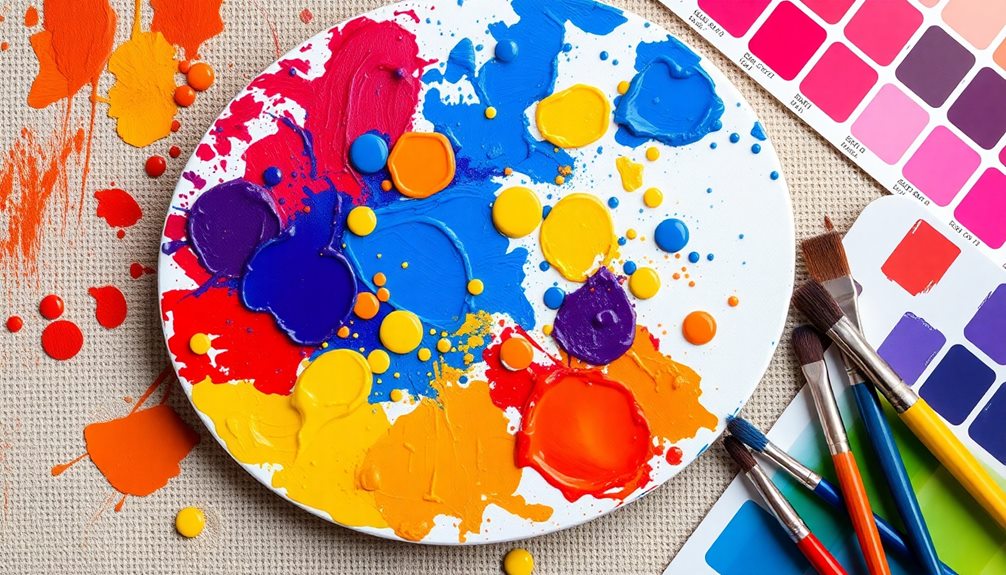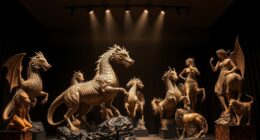When you write about color in art, you tap into its emotional and perceptual power. Start by familiarizing yourself with color theory, including the color wheel and the significance of warm versus cool colors. Techniques like using complementary color schemes or limited palettes can enhance your artwork's mood and cohesion. Look at how famous artists, like J.M.W. Turner or Matisse, employed color to evoke emotions. Remember, your audience's perception of colors varies widely. Engaging with your viewers' experiences can enrich your approach. Stick around to explore more tips on effectively communicating about color in your art.
Key Takeaways
- Understand the color wheel and color temperature to effectively categorize and use colors in artwork.
- Explore various color schemes, such as complementary and analogous, to create visual interest and harmony.
- Master color mixing techniques to expand your palette and enhance the emotional impact of your art.
- Recognize how audience perception of color varies by cultural context and personal experience to tailor your approach.
- Engage with art communities and seek feedback on color applications to refine your understanding and skills.
Introduction
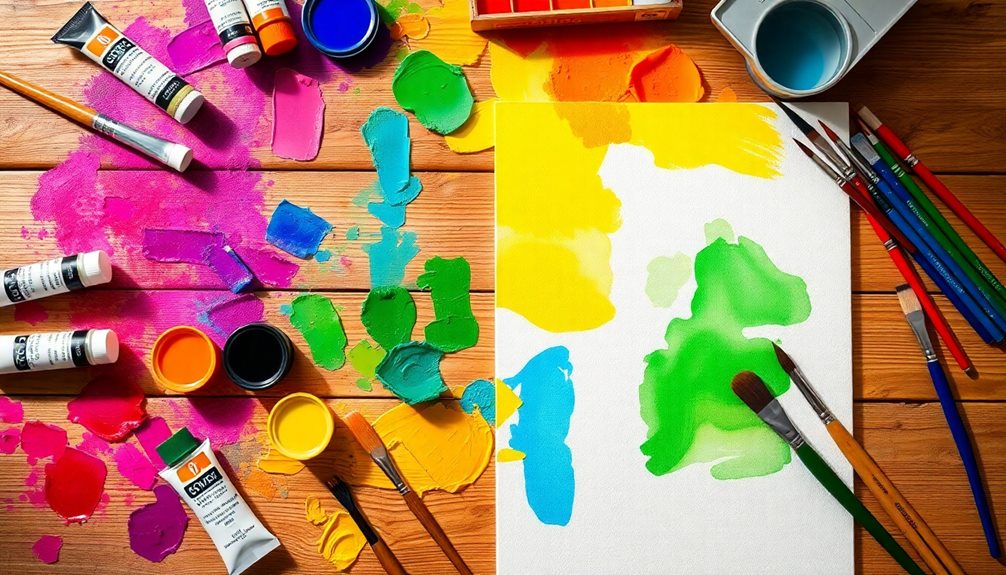
Color plays a crucial role in art, shaping both the creation and perception of a piece. When you understand color, you're tapping into a powerful tool that can influence emotions and convey meaning. The use of color isn't just about aesthetics; it's about engaging the viewer on a deeper level.
As you explore color theory, you'll discover how primary, secondary, and tertiary colors interact through the color wheel, guiding your choices in mixing and harmony.
In your artwork, the psychological responses to warm and cool colors can significantly impact how others perceive your work. Warm colors like reds and yellows can evoke energy and excitement, while cool colors like blues and greens bring a sense of calmness and serenity. By mastering these concepts, you enhance your ability to create mood and atmosphere in your pieces.
Historical art movements, such as Impressionism and Fauvism, have pushed the boundaries of color usage, showcasing the evolution of color theory. As you delve into these innovative approaches, you'll find inspiration that enriches your own artistic expression.
Understanding color is essential for any artist aiming to make a lasting impact.
Key Concepts and Definitions
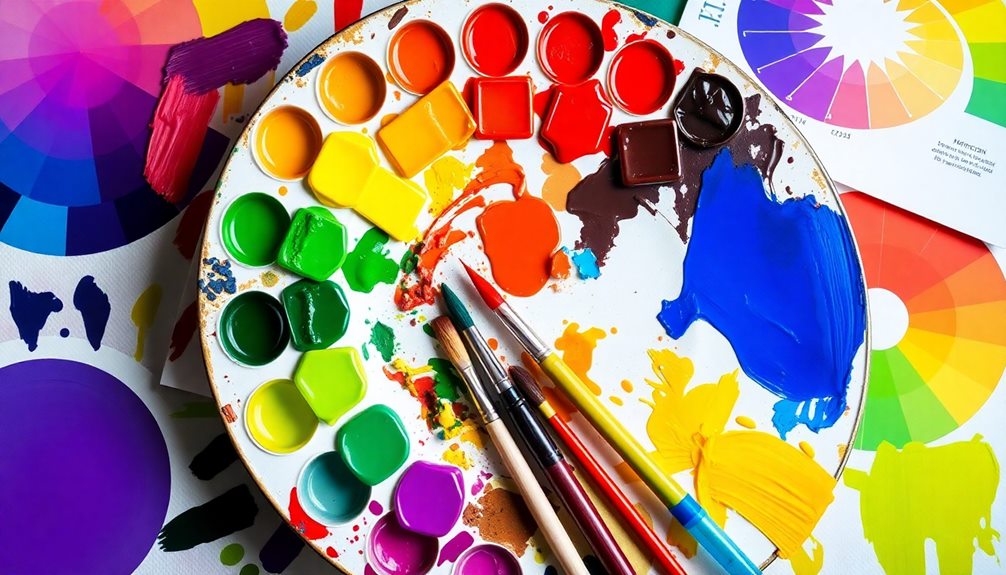
Understanding the key concepts and definitions of color theory is essential for any artist looking to enhance their work. At the heart of this theory lies the color wheel, which organizes colors into primary, secondary, and tertiary categories. Familiarizing yourself with this framework helps you grasp how colors interact.
One crucial concept is color temperature, which divides colors into warm colors like red and orange, and cool colors such as blue and green. This classification affects the mood and atmosphere of your artwork, guiding the emotional response you want to evoke in viewers.
You should also learn about complementary colors, which are located opposite each other on the color wheel. Using these in your compositions creates striking contrasts and visual interest.
Additionally, consider analogous and triadic color schemes, as they enhance harmony and balance in your work.
Color Application Techniques
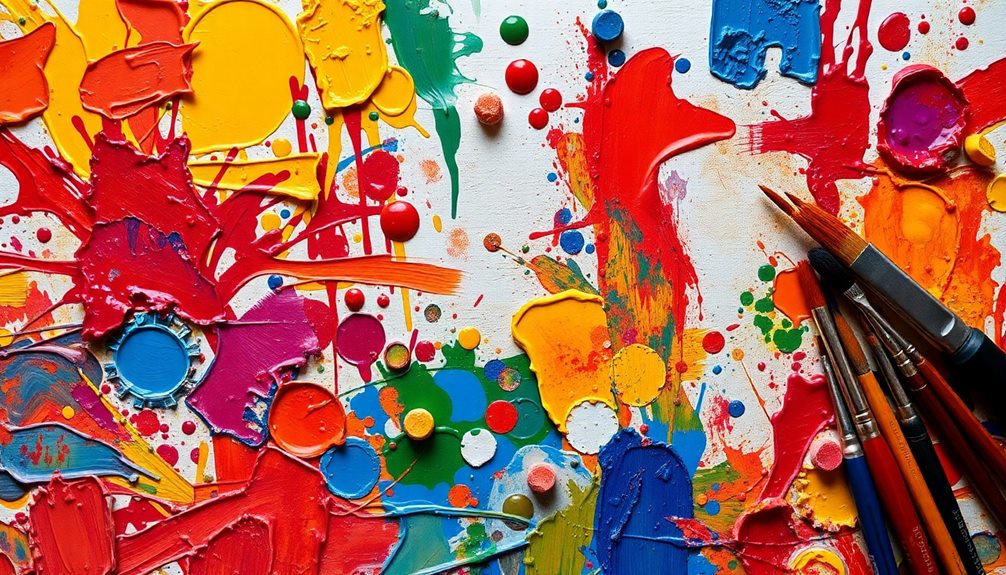
Mastering color application techniques can significantly elevate your artwork. Understanding how to mix primary colors with secondary ones lets you create a wide range of desired shades. This knowledge is essential for achieving accuracy in your color application.
To enhance your compositions, consider using complementary color combinations. By pairing opposite colors on the color wheel, you can create striking visual contrast and vibrancy that draws the viewer's eye.
Don't overlook the concept of color temperature, either. Recognizing the difference between warm and cool colors is crucial for setting the mood in your piece. It can greatly influence how viewers perceive your work.
Additionally, employing a limited color palette can help you establish a cohesive visual theme. This strategy allows for a more effective exploration of color relationships and emotional impact.
If you're working in digital mediums, familiarize yourself with color models like RGB and CMYK. Understanding these models informs your color application for both screens and print materials, ensuring consistency across different platforms.
Real-World Artist Applications
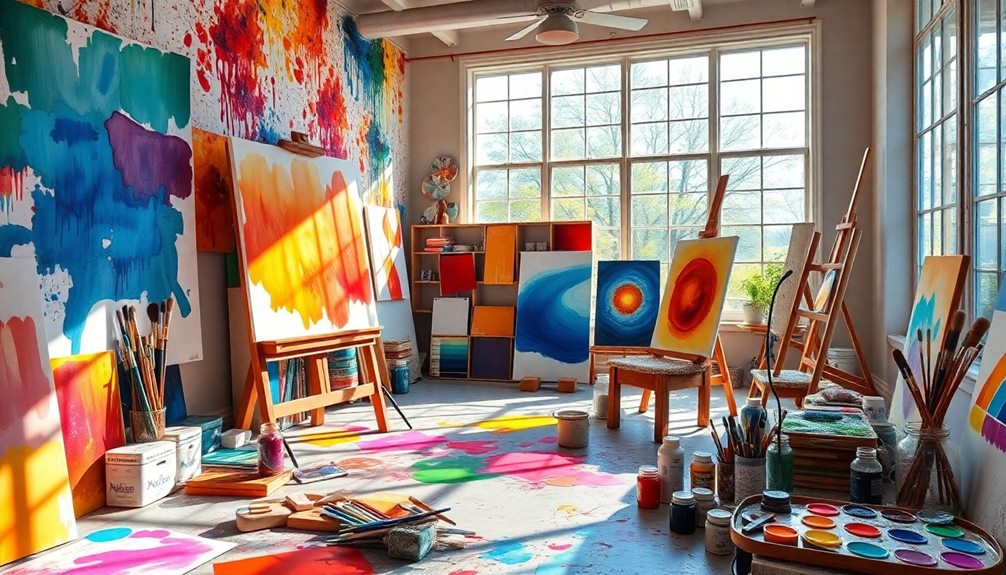
In the world of art, real-world applications of color theory bring vibrancy and emotion to life. Artists use this theory to create impactful works that resonate deeply with viewers.
Take J.M.W. Turner, for example; he utilized pure pigments and innovative color mixing techniques in his landscape paintings, capturing the essence of light and atmosphere. His sketchbooks reveal how he experimented with different colors to evoke specific feelings.
Similarly, Henri Matisse and André Derain, key figures in the Fauvism movement, employed complementary colors to convey strong emotions, creating dynamic visual experiences. Their bold use of color transformed ordinary scenes into powerful statements.
Mark Rothko's Seagram Murals further showcase the emotional impact of color, as he used deep color fields to evoke contemplation and introspection.
Contemporary artists like Bridget Riley build on these foundations, emphasizing the psychological and perceptual effects of color on viewer engagement. Contemporary artists like Bridget Riley build on these foundations, emphasizing the psychological and perceptual effects of color on viewer engagement. By manipulating intricate patterns and contrasting hues, Riley invites viewers to actively decode the visual stimuli before them, often prompting a meditative or transformative experience. This approach raises questions like “what is visual literacy?” and challenges audiences to consider how their ability to interpret visual cues shapes their understanding of art and the world around them. Through these explorations, artists bridge the gap between perception and interpretation, encouraging deeper connections with their work.
Lastly, Olafur Eliasson's experiments with Turner's techniques highlight the ongoing evolution of color in modern artistic practices, demonstrating that the relationship between light and color continues to inspire new interpretations and applications in art today.
Tips and Best Practices
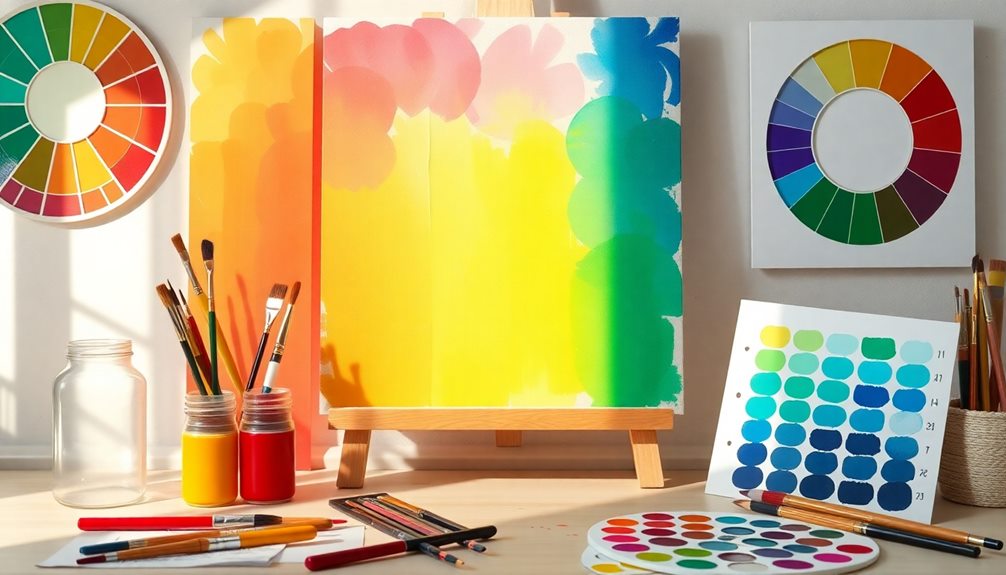
To effectively convey the essence of color in art, start by utilizing the color wheel to identify relationships between hues. Use complementary, analogous, and triadic schemes to create visual harmony in your descriptions.
Consider incorporating psychological associations of colors—like red for passion or blue for tranquility—to evoke specific emotions and deepen your readers' understanding of the artwork's impact.
When analyzing a piece, discuss the artist's color choices in terms of saturation and value. These elements are crucial in conveying the overall mood and theme of the work.
Explore the historical context of color usage by referencing how it's evolved through different art movements. For instance, Impressionism emphasized light and color interaction, while Fauvism showcased bold color applications.
Encourage descriptive precision by using specific color names and shades rather than general terms. This approach allows your readers to visualize the artwork more vividly and engage with the nuances of color in each piece.
Audience Engagement and Feedback
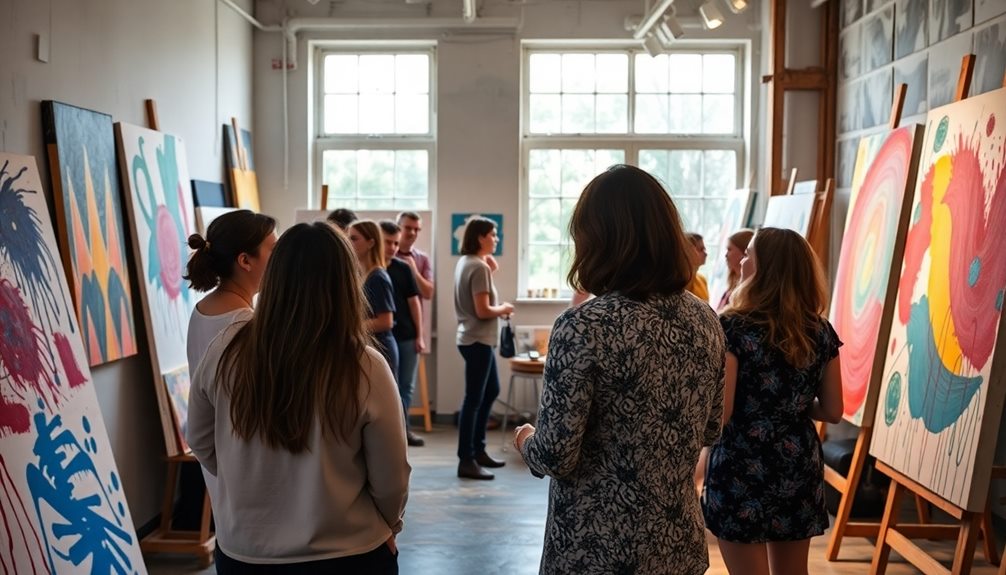
Engagement with your audience about color in art can significantly enhance their understanding and appreciation of your work. By encouraging feedback on your color choices, you create a supportive environment that fosters artistic growth.
Sharing personal experiences related to color can spark meaningful discussions, helping your audience connect more deeply with your artistic process.
Utilizing social media platforms is an effective way to showcase your artworks and solicit color-related feedback. This not only increases audience engagement but also builds a sense of community among artists and viewers.
Consider conducting color theory quizzes or interactive workshops to actively involve your audience. These activities help them apply their knowledge while receiving immediate feedback on their understanding.
Don't shy away from inviting critiques on specific color applications in your artwork. Regularly asking for comments can provide valuable insights and diverse perspectives, enriching your creative journey.
Engaging with your audience about color choices and being open to their feedback won't only enhance your art but also strengthen the bond between you and your viewers, leading to a more enriched artistic experience for everyone involved.
Audience Perception Variations
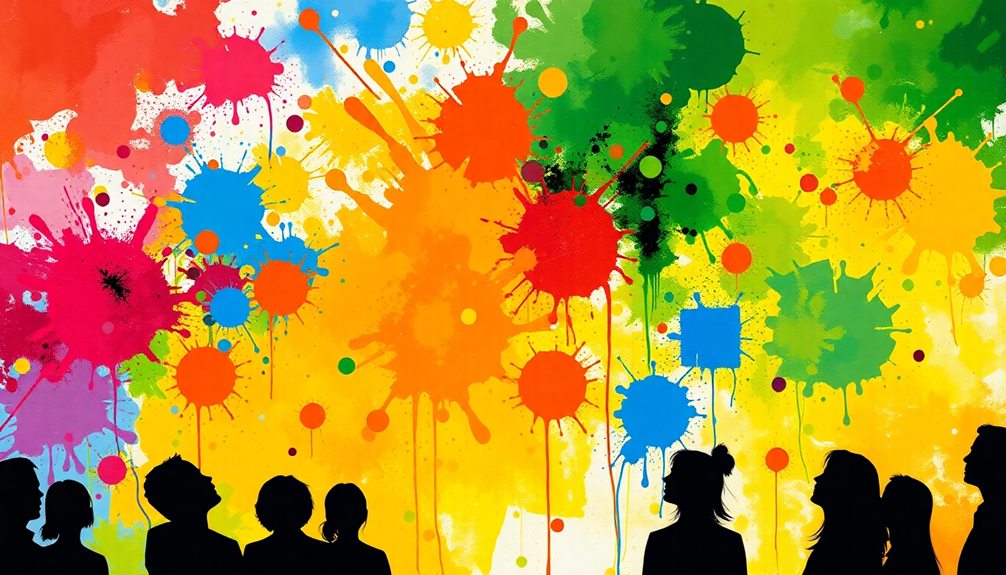
Understanding how your audience perceives color can provide valuable insights into their reactions to your artwork. Audience perception can vary greatly based on cultural backgrounds, personal experiences, and psychological responses. For instance, while you might interpret a vibrant red as passionate, someone else may see it as aggressive. This variation underscores the importance of using the principles of color theory effectively.
When you choose your colors, remember that warm hues like orange can evoke excitement, while cool shades like blue often promote calmness. The surrounding colors also play a crucial role; a hue might appear more vibrant or muted depending on adjacent tones. This contextual influence is essential in shaping how your audience perceives your work.
Moreover, familiarity with specific colors can lead to stronger emotional connections. If a viewer associates a particular shade with a cherished memory, their response to your artwork may change entirely.
Additional Resources

Exploring additional resources can significantly enhance your grasp of color in art. Start by diving into online platforms that feature color theory quizzes and interactive colour wheels. These tools help you visualize relationships between primary colors like blue and yellow to create vibrant secondary colors, such as green.
Additionally, consider incorporating essential oil benefits to create a calming atmosphere as you work on your art, enhancing your creativity and focus.
For deeper insights, check out recommended readings like "Interaction of Color" by Josef Albers and "Color: A Natural History of the Palette" by Victoria Finlay. These books offer valuable perspectives on color theory and its historical context.
Consider enrolling in painting workshops or courses that focus on color mixing techniques. Hands-on experience is crucial for mastering how to blend colors effectively in your artwork.
Don't forget to use a color thesaurus. It can provide you with varied and descriptive terms for colors, making your writing about color more vivid and engaging.
Lastly, engage with art communities, both online and offline. Sharing your experiences and receiving feedback on your color usage can foster a collaborative learning environment, helping you refine your understanding of color in art.
Frequently Asked Questions
How Do You Describe Colors in an Artwork?
When you describe colors in an artwork, focus on specific terms like hue and saturation. Relate colors to emotions or objects, and consider their psychological effects to create a vivid and engaging narrative.
How Do You Describe Color in Creative Writing?
When you describe color in creative writing, evoke emotions by linking hues to memories or sensations. Use specific shades, explore contrasts, and consider character perspectives to enhance your narrative and engage your readers more effectively.
How Do You Write About Colours?
When you write about colors, focus on vivid descriptions, use precise terms, and evoke emotions. Relate hues to familiar experiences, and explore symbolism to enhance imagery, making your writing more engaging and impactful for readers.
What Is the Significance of Color in Art?
Color's significance in art lies in its ability to evoke emotions, create depth, and convey messages. You can explore how different hues affect viewers' feelings, adding layers of meaning to your artistic expression and storytelling.
Conclusion
Incorporating color into your art can truly elevate your work and communicate powerful emotions. By understanding key concepts, experimenting with techniques, and learning from real artists, you can develop your unique style. Remember to engage with your audience and consider their perceptions, as this can deepen their connection to your art. Keep exploring and refining your approach, and don't hesitate to seek out additional resources to enhance your color knowledge. Your artistic journey is just beginning!
